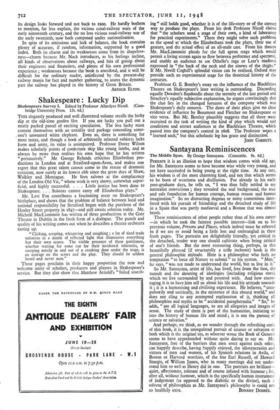Railways Again
The Railways of Britain. By 0. S. Nock. (Batsford. 15s.)
EXCEPT for theology, the theme of railway communications must have inspired more popular or semi-popular books, pamphlets and periodicals than any other. Indeed, the railway enthusiast brings to his passion a reverence only equalled by the author of Line Upon Line. Today railway literature may even have outstripped that devoted to piety. Even works locomotives and the remote Raven- glass and Eskdale Railway rate a book each. Today's railway fans belong to the family which bought and studied John Francis's History of the English Railway (1841) and F. S. Williams's Our Iron Roads (5850.
If the number of books devoted to railways is great, the same cannot be said of the ways in which they approach their subject. Authors and readers seem content if each book provides a faithful record of fact—numbers, dimensions and classes of locomotive ; dates of particular sections of line; sizes, dates and costs of bridges and tunnels; mileages, routes and the names of signal-boxes. Even the books' of the late C. F. Dendy Marshall, the most scholarly of all railway historians, are less interpretative histories than detailed marshallings of date and dimension. A book adequately relating railways to the social life and structure of the age which gave them birth has not yet been written.
Mr. Nock's excellently illustrated book is not an exception. Like the cross-country railway journey he mentions from Chippenham to Malvern (eighty-three miles by rail ; forty-seven miles as the crow flies), his book puffs agreeably through the railway landscape, some- times getting on to a main line for a burst of speed, and sometimes waiting at a junction to allow an express to go through. At these pauses we have time, if not to get out and pick buttercups, at least to study such topics as why, in The Mystery of Edwin Drood, Dickens sends his characters from Rochester to London by train from Maidstone Road Junction (forty-six miles), instead of by the then more direct road-coach route (twenty-nine miles). The reason, by the way, is surely obvious. Dickens's characters, like Mr. Nock himself and the author of this review, prefer railway travel to all other forms of locomotion, as some men prefer champagne to ginger pop. Mr. Nock finds an opportunity for a slap at Bulleid's taut, dramatic design for a goods-engine for the Southern in 1942. He feels it belongs to the cubist or surrealist school and lacks a balanced symmetry. In fact, unlike many of its contemporaries,
its design looks forward and not back to Iwo. He hardly bothers to mention, far less explain, the vicious canal-railway wars of the early nineteenth century, and the no less vicious road-railway war of the early twentieth, now both composed under nationalisation. In spite of its omissions and lack of balance, the book contains plenty of accurate, if random, information, supported by a good index. Both its charm and its weaknesses come from its shapeless- ness—charm because Mr. Nock introduces, as his feelings incline, all kinds of observations about railways, and bits of gossip about their engineers and financiers, and pieces of his own professional experience ; weaknesses because the book is anecdotal, and it will be difficult for the ordinary reader, uninfected by the present-day railway mania for fact and number gathering, to assess the dynamic part the railway has played in the history of Great Britain.
ARTHUR ELTON.































 Previous page
Previous page